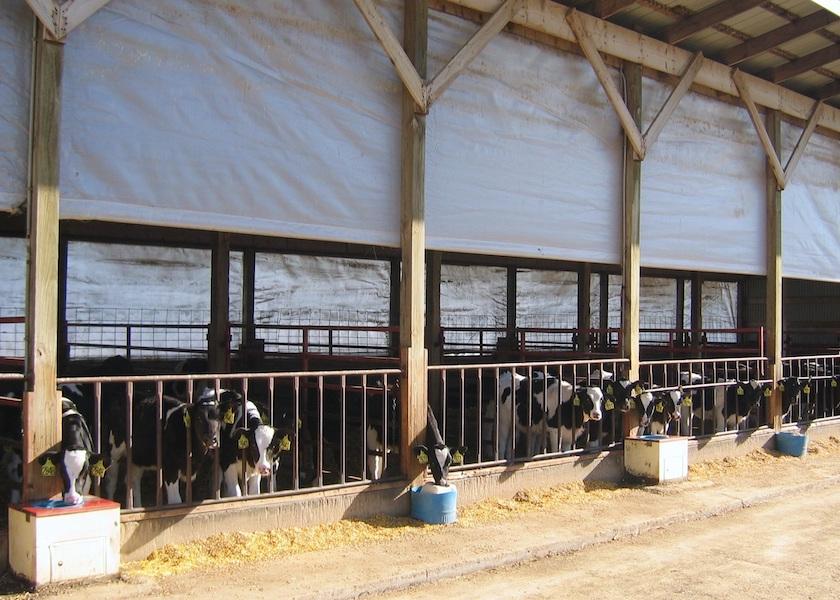Seven Tips for Avoiding the Post-weaning Slump

Preweaned calves require a lot of attention, labor and focus, and rightfully so. But if their transition to weaning goes awry, so, too, can their health and productivity.
According to the Dairy Calf and Heifer Association’s Gold Standards, 50% of lifetime stature growth and 25% of lifetime weight gain occur in the first 6 months of a dairy calf’s life. That means the weeks after weaning are just as critical as those before.
Here’s important advice for avoiding the post-weaning slump, offered by Dr. Donna Amaral-Phillips of the University of Kentucky Dairy Extension, and Dr. Troy Wistuba with Purina Animal Nutrition.
- Make one change at a time – To reduce the stress of weaning, make changes incrementally, advises Amaral-Phillips. Examples include dropping liquid rations back to 1X feedings for a few days or reducing autofeeder volumes before removing them entirely, and keeping calves on their preweaning grain mixture when they enter their new housing. Many producers also have success keeping calves in their preweaning housing environments for a week after weaning. The order of changes can be customized to the operation, but the point is to allow calves to adjust to one change before making another.
- Ease into dietary transitions – Wistuba warns that an abrupt shift from a mostly milk-based diet to a grain and forage ration disrupts the microbes living in the calf’s digestive tract. He advises feeding high-protein (22%) starter grain ad-lib for the first 10-12 weeks of life until they reach 10 pounds of daily intake, then transitioning them to a high-protein (18%) grower feed with free-choice hay for another 12 weeks.
- House in small groups – Amaral-Phillips suggests the first post-weaning grouping of individually or buddy-reared calves should consist of 6 head or fewer. This allows heifers to learn how to interact in a group setting, find the water source, and access the feed bunk without stressful competition. Calves raised in autofeeder pens should be maintained in their same groups after weaning.
- Make facilities user-friendly – “Dairy heifers from 2 to 4 months of age need 12 to 18 inches of feed bunk space per head,” said Amaral-Phillips. “The height must allow all animals to easily reach the feed trough as well.” As in preweaned facilities, ample air movement without creating a draft should be the goal. She also said shelter, dry bedding and a walking surface free of mud, ice and snow also are essential so heifers do not divert extra energy to stay warm and walking to the feed source.
- Feed for their needs – “Too often, the mindset when it comes to feeding heifers is, ‘what’s available?’ versus ‘what do these heifers need?’” said Wistuba. Considering the total protein content of their ration is critical, according to Amaral-Phillips. “In young heifers, lower-protein grain mixes (12-14% crude protein) often do not allow for adequate protein intake for skeletal growth when paired with forages testing less than 18-20% crude protein,” she said.
- Include a coccidiocide – Controlling coccidiosis helps keep weaned calves on a healthy plane of growth. Amaral-Phillips notes that adding a coccidiocide, i.e. Rumensin or Bovatec, to the post-weaned ration is especially important if Deccox was included in the preweaned starter grain. “If a coccidiostat, i.e. Deccox, is removed from the diet after weaning, the coccidian protozoa can complete their life cycle and cause a break in coccidiosis protection,” she explained. Coccidiocides also have been shown to improve feed efficiency and weight gain.
- Give the rumen its due – While you see how weaned calves are doing on the outside, important events are occurring inside. According to Wistuba, rumen volume doubles five times from 8-24 weeks of life. Feeding starter grain and free-choice water as early as Day 3 after birth triggers chemical reactions that fuel papillae development in the rumen wall. But switching to a mostly forage diet – be it hay, silage or a high-forage TMR – immediately at weaning can abruptly put the brakes on rumen development and impact long-term feed efficiency. Both experts advise including a balanced grain component in the ration until 24 weeks of age. By then, the rumen is fully developed, and heifers are ready to transition to a fermented forage diet.
Taking these measures will help to ensure that the effort, resources and time spent in the preweaning phase will not be lost in the post-weaning period. “There’s no ‘undo’ button or way to make up for lost ground during post-weaning,” said Wistuba.







